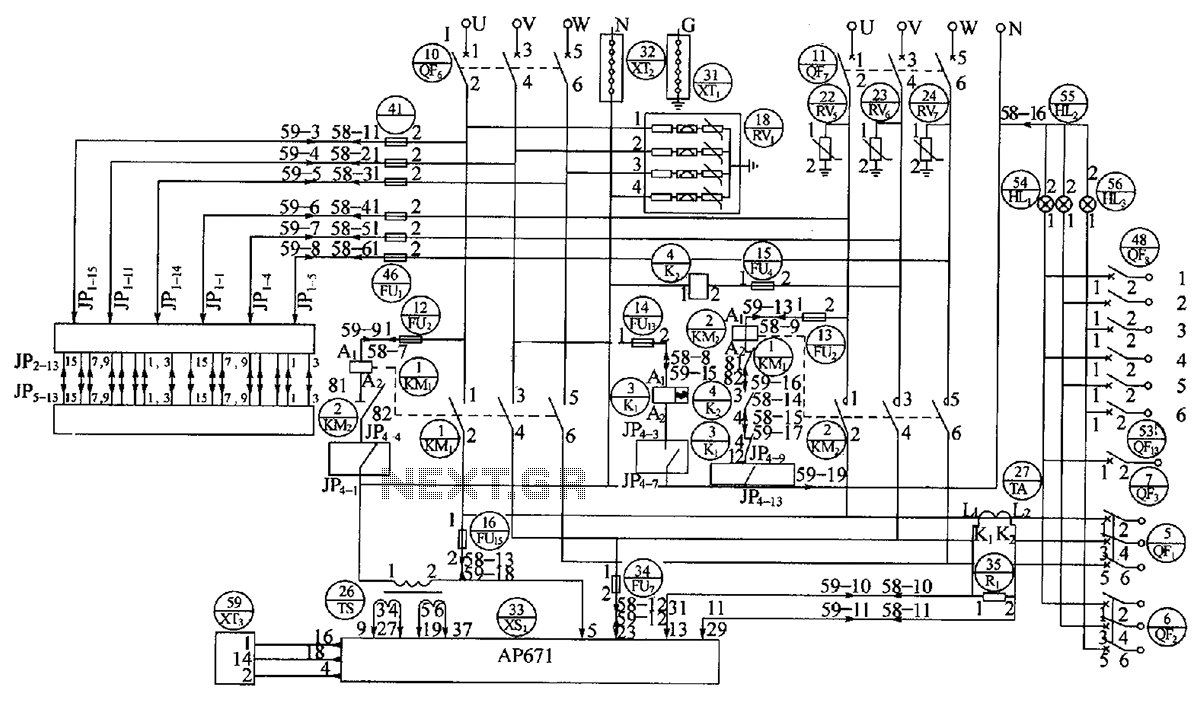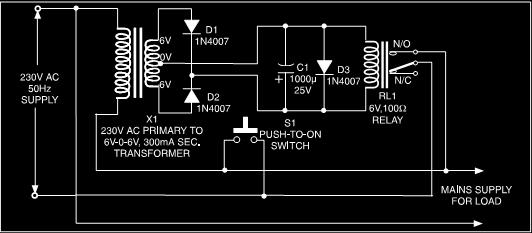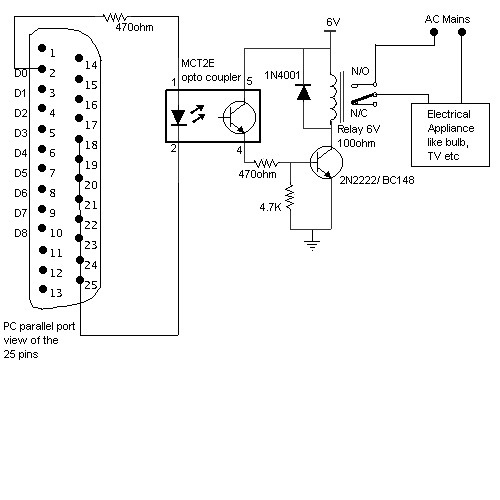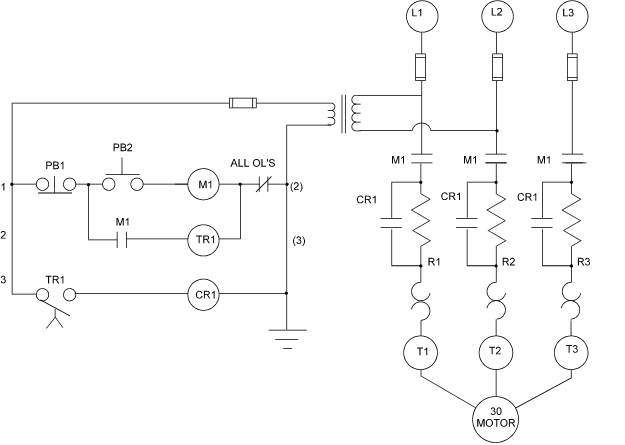
Electrical modeling of a nanopore measurement
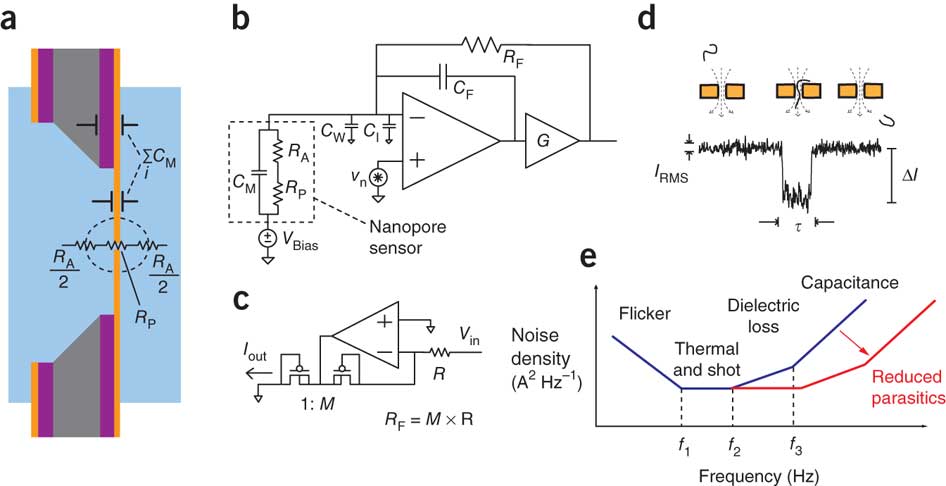
An illustration of the electronic impedances of a solid-state nanopore chip. A simplified circuit schematic of the voltage-clamp current preamplifier is provided. The circuit design of the low-noise current source substitutes for a feedback resistance (RF). An example transient current pulse is shown, characteristic of a single-molecule event. The dominant sources of noise power spectral density are illustrated as a function of frequency. The platform concept was developed by J. K. R., K. L. S., and M. D. The amplifier and measurement system were designed by J. K. R. Experiments were planned by J. K. R., K. L. S., M. W., and M. D. Nanopores were fabricated by M. W. and C. A. M. Nanopore experiments and data analysis were performed by J. K. R. and M. W. The manuscript was written by J. K. R. and K. L. S., with contributions from all authors.
The electronic impedances of a solid-state nanopore chip play a crucial role in its functionality, particularly in applications such as DNA sequencing and single-molecule detection. The voltage-clamp current preamplifier is a vital component of the circuit schematic, designed to maintain a stable voltage across the nanopore while measuring the resulting current fluctuations. This configuration allows for precise control and measurement of ionic currents that occur as molecules pass through the nanopore.
The low-noise current source included in the design serves as a replacement for a feedback resistance (RF), which is essential to minimize the impact of thermal and electronic noise on the measurements. By employing a low-noise current source, the system can achieve higher sensitivity and accuracy in detecting transient current pulses that are indicative of single-molecule events. These pulses are characterized by their amplitude and duration, which provide information about the size and translocation speed of the molecules.
Additionally, the noise power spectral density is a critical parameter, illustrated as a function of frequency. Understanding the dominant sources of noise helps in optimizing the design and operation of the nanopore chip, ensuring that the signal-to-noise ratio is maximized for effective detection and analysis.
The collaborative efforts of the research team, including the design of the amplifier, planning of experiments, fabrication of nanopores, and analysis of data, highlight the interdisciplinary nature of this work. The manuscript detailing these findings reflects the collective contributions of all authors involved in the project, emphasizing the importance of teamwork in advancing the field of solid-state nanopore technology.An illustration of the electronic impedances of a solid-state nanopore chip. (b) Simplified circuit schematic of the voltage-clamp current preamplifier. (c) Circuit design of the low-noise current source that substitutes for a feedback resistance (RF). (d) An example transient current pulse, characteristic of a single-molecule event such as th e one illustrated. (e) Dominant sources of noise power spectral density, illustrated as a function of frequency. J. K. R. , K. L. S. and M. D. developed the platform concept. J. K. R. designed the amplifier and measurement system. J. K. R. , K. L. S. , M. W. and M. D. planned experiments. M. W. and C. A. M. fabricated nanopores. J. K. R. and M. W. performed nanopore experiments and analyzed data. J. K. R. and K. L. S. wrote the manuscript. All authors edited the manuscript. 🔗 External reference
The electronic impedances of a solid-state nanopore chip play a crucial role in its functionality, particularly in applications such as DNA sequencing and single-molecule detection. The voltage-clamp current preamplifier is a vital component of the circuit schematic, designed to maintain a stable voltage across the nanopore while measuring the resulting current fluctuations. This configuration allows for precise control and measurement of ionic currents that occur as molecules pass through the nanopore.
The low-noise current source included in the design serves as a replacement for a feedback resistance (RF), which is essential to minimize the impact of thermal and electronic noise on the measurements. By employing a low-noise current source, the system can achieve higher sensitivity and accuracy in detecting transient current pulses that are indicative of single-molecule events. These pulses are characterized by their amplitude and duration, which provide information about the size and translocation speed of the molecules.
Additionally, the noise power spectral density is a critical parameter, illustrated as a function of frequency. Understanding the dominant sources of noise helps in optimizing the design and operation of the nanopore chip, ensuring that the signal-to-noise ratio is maximized for effective detection and analysis.
The collaborative efforts of the research team, including the design of the amplifier, planning of experiments, fabrication of nanopores, and analysis of data, highlight the interdisciplinary nature of this work. The manuscript detailing these findings reflects the collective contributions of all authors involved in the project, emphasizing the importance of teamwork in advancing the field of solid-state nanopore technology.An illustration of the electronic impedances of a solid-state nanopore chip. (b) Simplified circuit schematic of the voltage-clamp current preamplifier. (c) Circuit design of the low-noise current source that substitutes for a feedback resistance (RF). (d) An example transient current pulse, characteristic of a single-molecule event such as th e one illustrated. (e) Dominant sources of noise power spectral density, illustrated as a function of frequency. J. K. R. , K. L. S. and M. D. developed the platform concept. J. K. R. designed the amplifier and measurement system. J. K. R. , K. L. S. , M. W. and M. D. planned experiments. M. W. and C. A. M. fabricated nanopores. J. K. R. and M. W. performed nanopore experiments and analyzed data. J. K. R. and K. L. S. wrote the manuscript. All authors edited the manuscript. 🔗 External reference
Warning: include(partials/cookie-banner.php): Failed to open stream: Permission denied in /var/www/html/nextgr/view-circuit.php on line 713
Warning: include(): Failed opening 'partials/cookie-banner.php' for inclusion (include_path='.:/usr/share/php') in /var/www/html/nextgr/view-circuit.php on line 713
